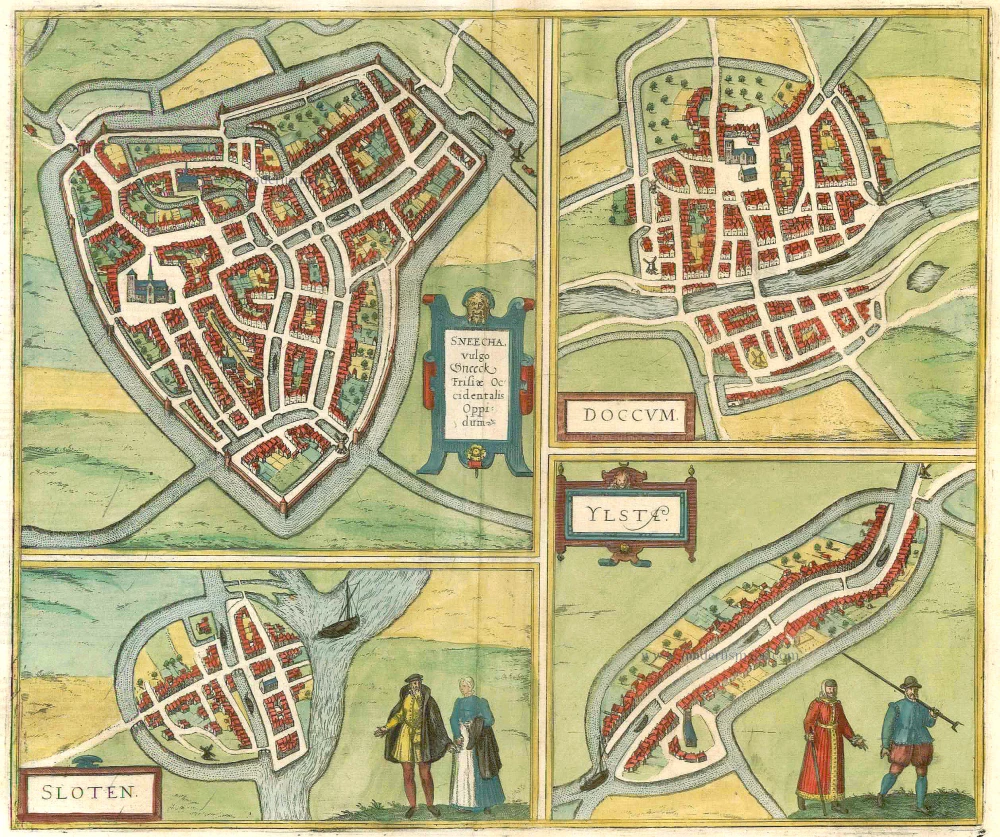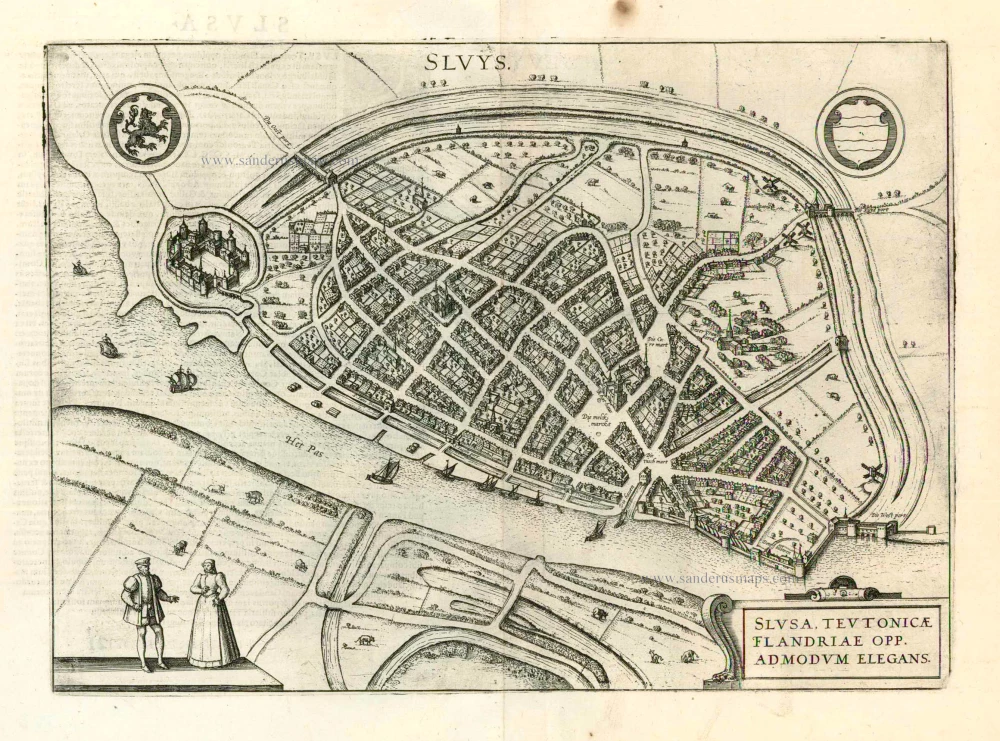Delft, by Braun & Hogenberg. 1582
TRANSLATION OF TEXT IN CARTOUCHE: Delphum, a highly cultivated city in Holland, named after the canal of the same name, in Dutch Delft.
COMMENTARY BY BRAUN: "Delft is surrounded by thick ring walls and with such a wide moat that even a strong man can barely throw a stone across it. The buildings within are magnificently constructed. If we start with the churches, first mention must go to the main church, called the New Church, a large, magnificent and beautiful church dedicated to St Ursula. There is also a large market in the city."
The city, criss-crossed by numerous narrow canals, is seen in a bird's-eye from the east. Its main buildings, on other hand, are presented in an impressive fashion in side view: the New Church (Nieuwe Kerck) on the market square with its enormous tower and the Gothic town hall (Das Rath huis). Granted its charter in 1246, Delft became an important centre of trade for the region. In 1618 the town hall burned to the ground and - with the exception of its prison tower Het Steen - thus no longer survives in the form illustrated here. Not far from the central market square rises the Oude Kerk, whose leaning tower, known as the "Lange Jan", has become Delft's landmark. Behind the Oude Kerk lies the convent of Sint-Agatha, today known as the Prinsenhof (Prince's Court), since William I, Prince of Orange, resided here. (Taschen)
Braun G. & Hogenberg F. and the Civitates Orbis Terrarum.
The Civitates Orbis Terrarum, also known as the 'Braun & Hogenberg', is a six-volume town atlas and the most excellent book of town views and plans ever published: 363 engravings, sometimes beautifully coloured. It was one of the best-selling works in the last quarter of the 16th century. Georg Braun, a skilled writer, wrote the text accompanying the plans and views on the verso. Many plates were engraved after the original drawings of a professional artist, Joris Hoefnagel (1542-1600). The first volume was published in Latin in 1572 and the sixth in 1617. Frans Hogenberg, a talented engraver, created the tables for volumes I through IV, and Simon van den Neuwel made those for volumes V and VI. Other contributors were cartographers Daniel Freese and Heinrich Rantzau, who provided valuable geographical information. Works by Jacob van Deventer, Sebastian Münster, and Johannes Stumpf were also used as references. Translations appeared in German and French, making the atlas accessible to a broader audience.
Since its original publication of volume 1 in 1572, the Civitates Orbis Terrarum has left an indelible mark on the history of cartography. Seven more editions followed the first volume in 1575, 1577, 1582, 1588, 1593, 1599, and 1612. Vol.2, initially released in 1575, saw subsequent editions in 1597 and 1612. The subsequent volumes, each a treasure trove of historical insights, graced the world in 1581, 1588, 1593, 1599, and 1606. The German translation of the first volume, a testament to its widespread appeal, debuted in 1574, followed by the French edition in 1575.
Several printers were involved: Theodor Graminaeus, Heinrich von Aich, Gottfried von Kempen, Johannis Sinniger, Bertram Buchholtz, and Peter von Brachel, all of whom worked in Cologne.
Georg Braun (1541-1622)
Georg Braun, the author of the text accompanying the plans and views in the Civitates Orbis Terrarum, was born in Cologne in 1541. After his studies in Cologne, he entered the Jesuit Order as a novice, indicating his commitment to learning and intellectual pursuits. In 1561, he obtained his bachelor's degree; in 1562, he received his Magister Artium, further demonstrating his academic achievements. Although he left the Jesuit Order, he continued his studies in theology, gaining a licentiate in theology. His theological background likely influenced the content and tone of the text in the Civitates Orbis Terrarum, adding a unique perspective to the work.
Frans Hogenberg (1535-1590)
Frans Hogenberg was a Flemish and German painter, engraver, and mapmaker. He was born in Mechelen as the son of Nicolaas Hogenberg.
By the end of the 1560s, Frans Hogenberg was employed upon Abraham Ortelius's Theatrum Orbis Terrarum, published in 1570; he is named an engraver of numerous maps. In 1568, he was banned from Antwerp by the Duke of Alva and travelled to London, where he stayed a few years before emigrating to Cologne. He immediately embarked on his two most important works, the Civitates, published in 1572 and the Geschichtsblätter, which appeared in several series from 1569 until about 1587.
Thanks to large-scale projects like the Geschichtsblätter and the Civitates, Hogenberg's social circumstances improved with each passing year. He died as a wealthy man in Cologne in 1590.
Deelft - Delphium Urbs Hollandiae cultissima ab eiusdem nominis fossa vulgo, Delfft appellata.
Item Number: 17166 Authenticity Guarantee
Category: Antique maps > Europe > The Netherlands - Cities
Old antique plan of Delft by Braun & Hogenberg.
Title: Deelft - Delphum Urbs Hollandiae cultissima ab eiusdem nominis fossa vulgo, Delfft appellata.
Date of the first edition: 1581.
Date of this map: 1582.
Copper engraving, printed on paper.
Size (not including margins): 356 x 485mm (14.02 x 19.09 inches).
Verso: German text.
Condition: Some light browning along the centrefold.
Condition Rating: A+.
From: Contrafactur und Beschreibung von den vornembsten Stetten der Welt. Liber Tertius. Köln, 1582. (Van der Krogt 4, 41:2.3)
TRANSLATION OF TEXT IN CARTOUCHE: Delphum, a highly cultivated city in Holland, named after the canal of the same name, in Dutch Delft.
COMMENTARY BY BRAUN: "Delft is surrounded by thick ring walls and with such a wide moat that even a strong man can barely throw a stone across it. The buildings within are magnificently constructed. If we start with the churches, first mention must go to the main church, called the New Church, a large, magnificent and beautiful church dedicated to St Ursula. There is also a large market in the city."
The city, criss-crossed by numerous narrow canals, is seen in a bird's-eye from the east. Its main buildings, on other hand, are presented in an impressive fashion in side view: the New Church (Nieuwe Kerck) on the market square with its enormous tower and the Gothic town hall (Das Rath huis). Granted its charter in 1246, Delft became an important centre of trade for the region. In 1618 the town hall burned to the ground and - with the exception of its prison tower Het Steen - thus no longer survives in the form illustrated here. Not far from the central market square rises the Oude Kerk, whose leaning tower, known as the "Lange Jan", has become Delft's landmark. Behind the Oude Kerk lies the convent of Sint-Agatha, today known as the Prinsenhof (Prince's Court), since William I, Prince of Orange, resided here. (Taschen)
Braun G. & Hogenberg F. and the Civitates Orbis Terrarum.
The Civitates Orbis Terrarum, also known as the 'Braun & Hogenberg', is a six-volume town atlas and the most excellent book of town views and plans ever published: 363 engravings, sometimes beautifully coloured. It was one of the best-selling works in the last quarter of the 16th century. Georg Braun, a skilled writer, wrote the text accompanying the plans and views on the verso. Many plates were engraved after the original drawings of a professional artist, Joris Hoefnagel (1542-1600). The first volume was published in Latin in 1572 and the sixth in 1617. Frans Hogenberg, a talented engraver, created the tables for volumes I through IV, and Simon van den Neuwel made those for volumes V and VI. Other contributors were cartographers Daniel Freese and Heinrich Rantzau, who provided valuable geographical information. Works by Jacob van Deventer, Sebastian Münster, and Johannes Stumpf were also used as references. Translations appeared in German and French, making the atlas accessible to a broader audience.
Since its original publication of volume 1 in 1572, the Civitates Orbis Terrarum has left an indelible mark on the history of cartography. Seven more editions followed the first volume in 1575, 1577, 1582, 1588, 1593, 1599, and 1612. Vol.2, initially released in 1575, saw subsequent editions in 1597 and 1612. The subsequent volumes, each a treasure trove of historical insights, graced the world in 1581, 1588, 1593, 1599, and 1606. The German translation of the first volume, a testament to its widespread appeal, debuted in 1574, followed by the French edition in 1575.
Several printers were involved: Theodor Graminaeus, Heinrich von Aich, Gottfried von Kempen, Johannis Sinniger, Bertram Buchholtz, and Peter von Brachel, all of whom worked in Cologne.
Georg Braun (1541-1622)
Georg Braun, the author of the text accompanying the plans and views in the Civitates Orbis Terrarum, was born in Cologne in 1541. After his studies in Cologne, he entered the Jesuit Order as a novice, indicating his commitment to learning and intellectual pursuits. In 1561, he obtained his bachelor's degree; in 1562, he received his Magister Artium, further demonstrating his academic achievements. Although he left the Jesuit Order, he continued his studies in theology, gaining a licentiate in theology. His theological background likely influenced the content and tone of the text in the Civitates Orbis Terrarum, adding a unique perspective to the work.
Frans Hogenberg (1535-1590)
Frans Hogenberg was a Flemish and German painter, engraver, and mapmaker. He was born in Mechelen as the son of Nicolaas Hogenberg.
By the end of the 1560s, Frans Hogenberg was employed upon Abraham Ortelius's Theatrum Orbis Terrarum, published in 1570; he is named an engraver of numerous maps. In 1568, he was banned from Antwerp by the Duke of Alva and travelled to London, where he stayed a few years before emigrating to Cologne. He immediately embarked on his two most important works, the Civitates, published in 1572 and the Geschichtsblätter, which appeared in several series from 1569 until about 1587.
Thanks to large-scale projects like the Geschichtsblätter and the Civitates, Hogenberg's social circumstances improved with each passing year. He died as a wealthy man in Cologne in 1590.









